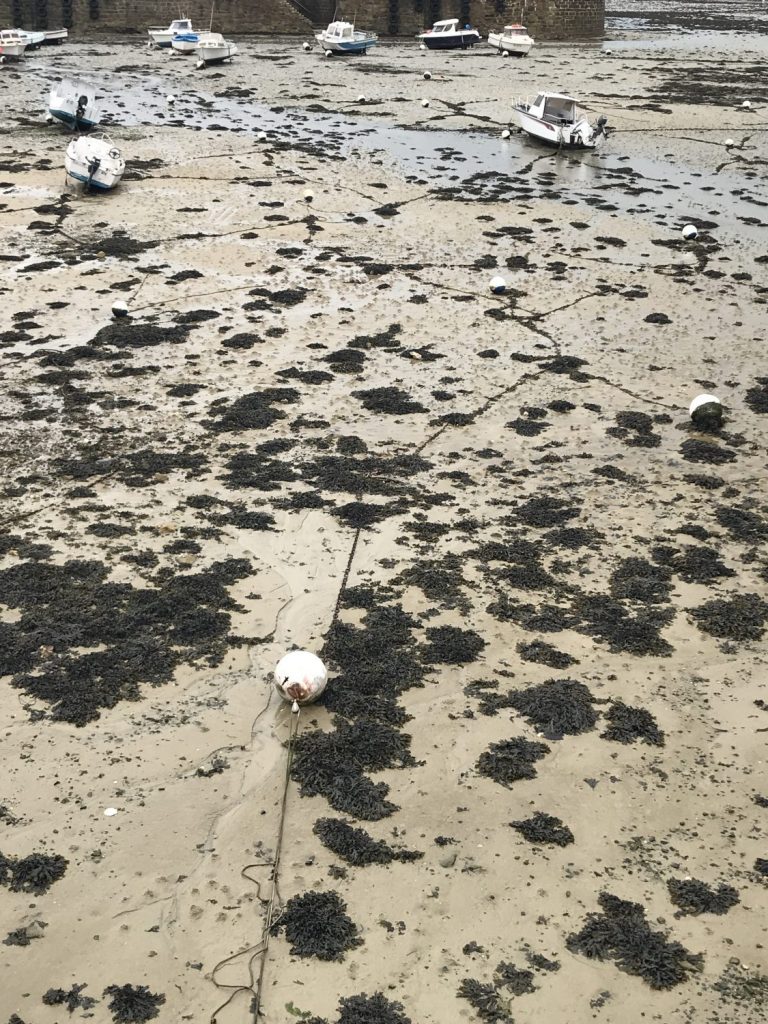Belle île had an old world Gallic charm to it that seduced us as well as for many other visitors. The colours on the windows, shutters and shop signs are an easy on the eye light pastel colour, life is slow and there is a creperie at almost every corner. 
First port of call was Sauzon, inching the boat up into the drying harbour carefully dropping the anchor, the water started to drop! It was nerve racking, there is not much time to maneover the legs which sit at either side of the boat to hold it in place. You can quickly dial them up or down on either side of the boat and then wait and hope they will hold fast! The water drops fast but once it finally retreated from below the keel we could lower ourselves part of the way and then plop into the mud below! The glamorous task of cleaning the anti foul awaited. This was really a highlight of the trip as cold blue and algae sludge drips down your bare arms. However despite the strong wind, the legs were thankfully holding fast or you could be in trouble fast, with the possibility of the boat topplying over and not much you can do about it. The port village was serine and tranquil, possible the nicest we visited. Little whitewashed houses stacked up against each other, their golden lights gently glistening in the dark that evening. 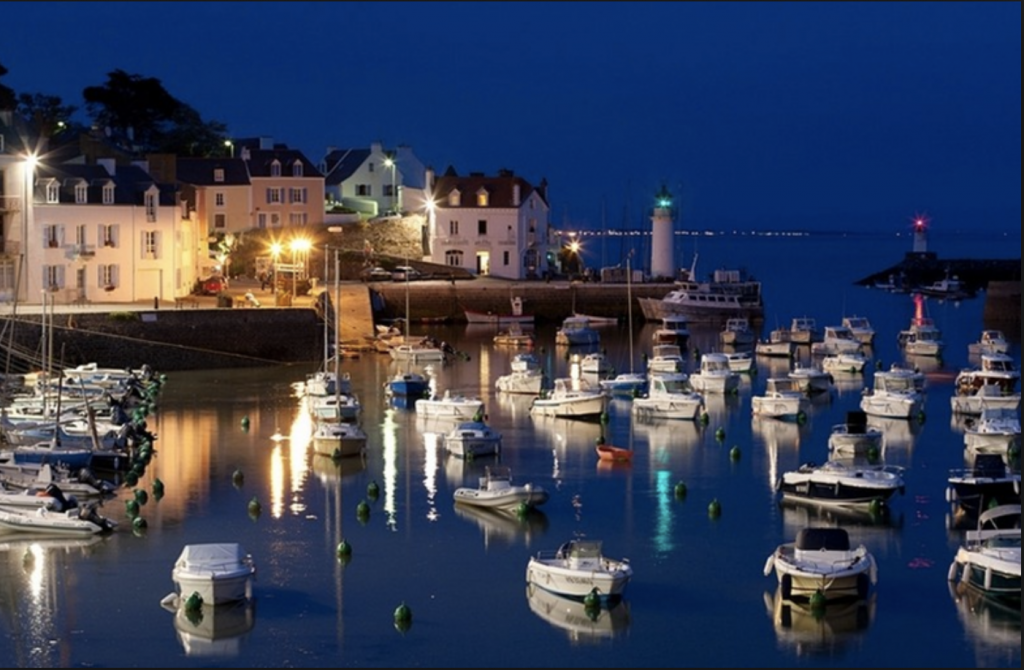
After two nights on the beaching legs we moved back onto a mooring buoy here though the chop proved difficult to avoid boats colliding with each other, not happy to leave Shadowfax like this while going on a bike adventure we pushed onto le Palais. However, here a fraught hour was spent waiting on the choppy dock with wash from frequent ferries and sea swell saw us and a number of other boats try to moor up alongside the picturesque citadel rising high above in order to enter the calm locked harbour. We ended up casting off again as it was too hazardous. Due to the swell making it difficult for everyone to anchor, inside the locked gate was busy and little room to manoever and we ended up getting hit on the bow by a training boat trying to leave. After this it did all seem to settle down though.
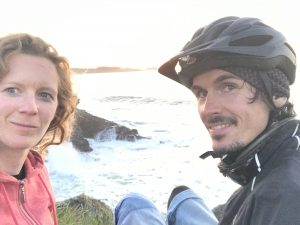
The plan was so to leave the boat for a stint inland cycling around the island, the was a great success and highly recommended for anyone thinking of it. we ended up bivvying out ‘sous les belle etoiles’ (Small film to follow)
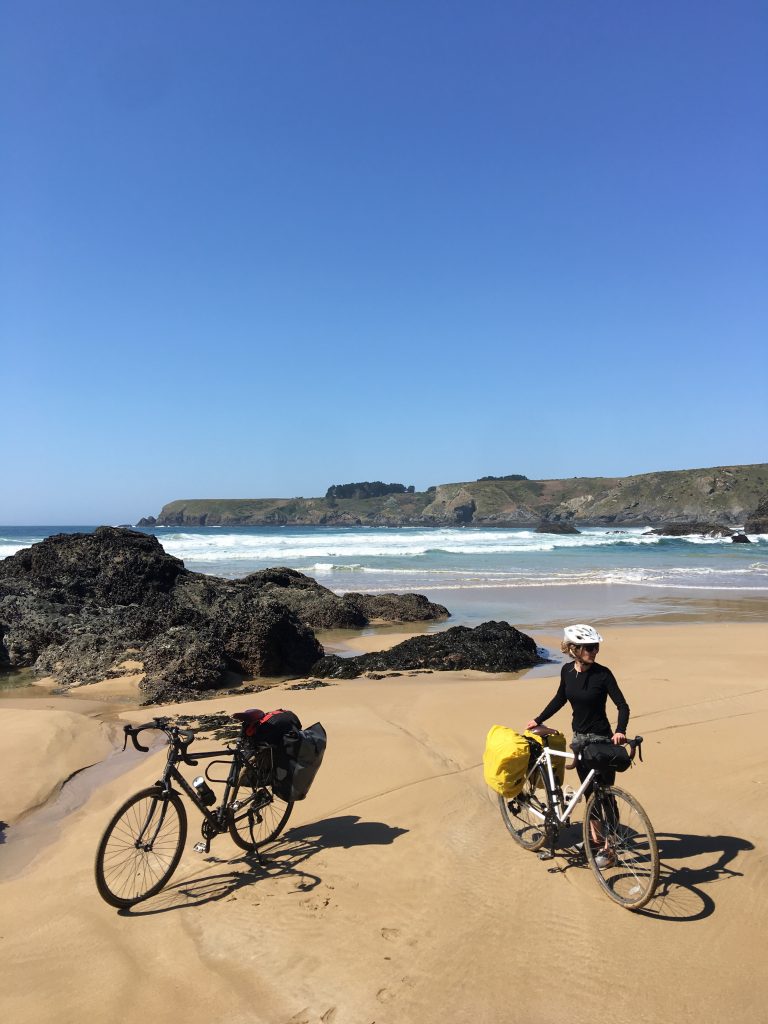
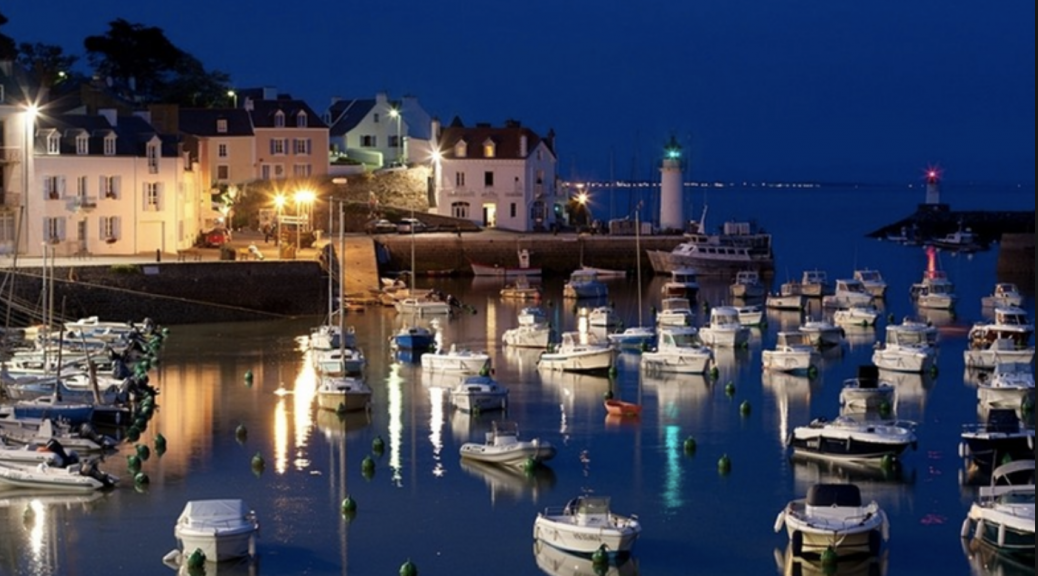
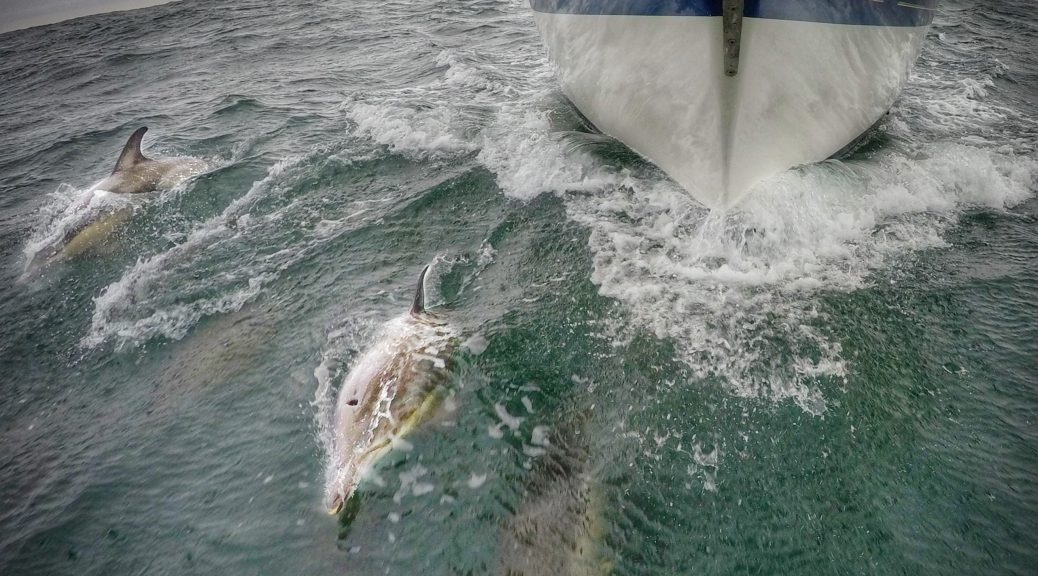
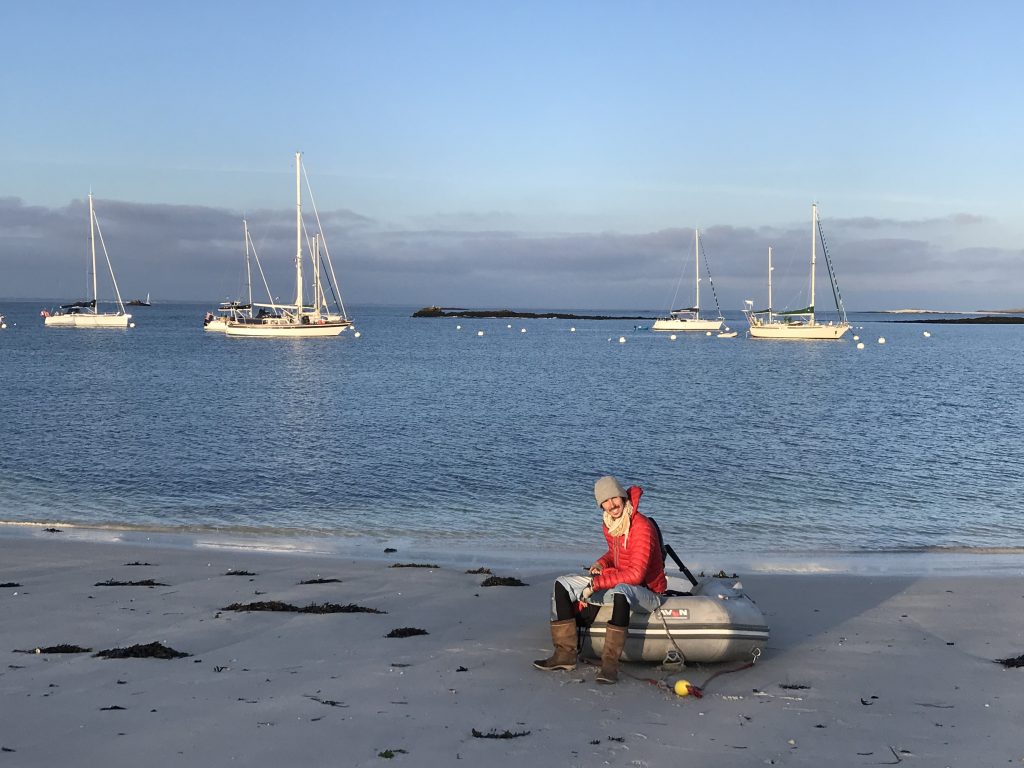 Turquoise waters and huge (clean!) sandy beaches. It is the only place to find a rare narcissus which grows on one of the islands, different to other varieties its head dips demurely and perhaps rather sadly more like a bluebell than the happy daffodil family but none the less delicately.
Turquoise waters and huge (clean!) sandy beaches. It is the only place to find a rare narcissus which grows on one of the islands, different to other varieties its head dips demurely and perhaps rather sadly more like a bluebell than the happy daffodil family but none the less delicately. 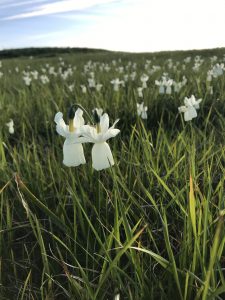 That evening moored up, which had taken some time to find as it is all relatively shallow, we were cooking when through the hull of the boat came strange noices. Running on deck there was an unusual scene… A dolphin with a deep piecing roaring noice was assertively head diving around the mooring buoy Shadowfax was attached to. He then moved onto several of the other boats before returning to the stern where he appeared to want to have some interaction and attention, trying to get as close as possible to us, perched on a little ledge. He seemed friendly but strong, this was a big dolphin quite different to the smaller ones we had seen swimming together before….
That evening moored up, which had taken some time to find as it is all relatively shallow, we were cooking when through the hull of the boat came strange noices. Running on deck there was an unusual scene… A dolphin with a deep piecing roaring noice was assertively head diving around the mooring buoy Shadowfax was attached to. He then moved onto several of the other boats before returning to the stern where he appeared to want to have some interaction and attention, trying to get as close as possible to us, perched on a little ledge. He seemed friendly but strong, this was a big dolphin quite different to the smaller ones we had seen swimming together before….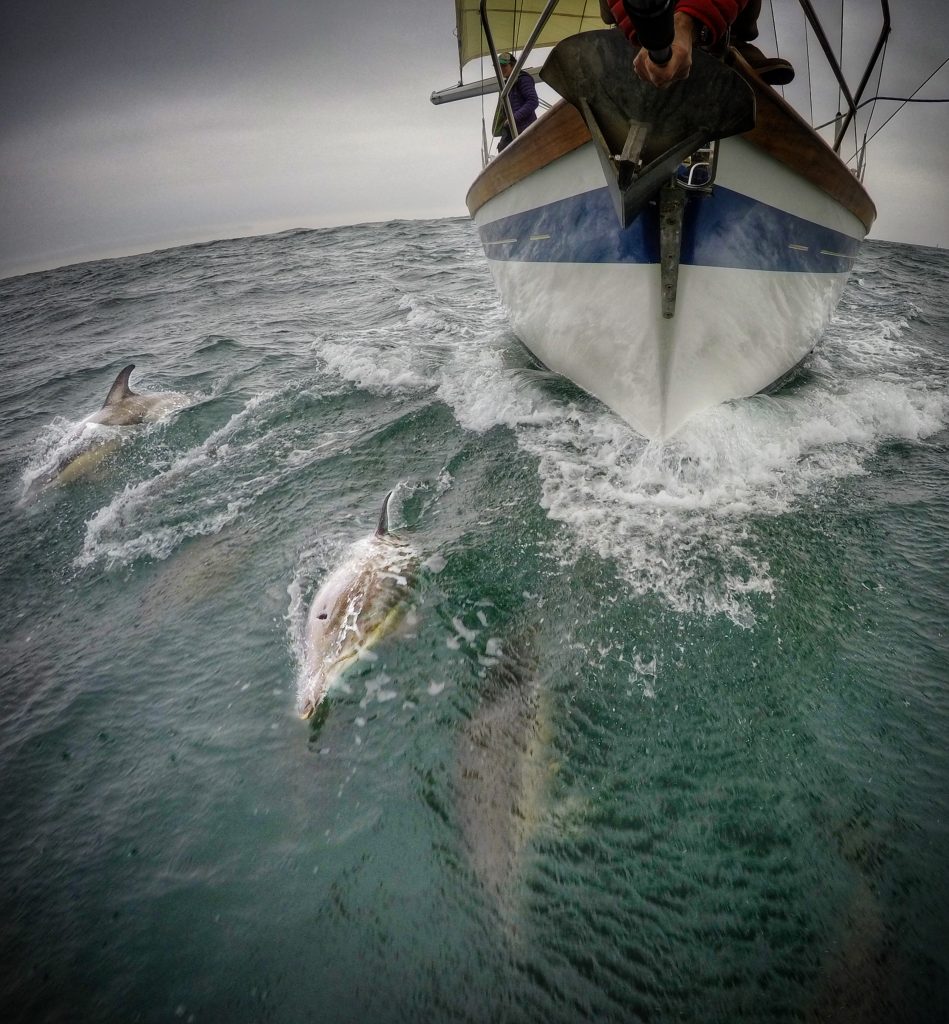
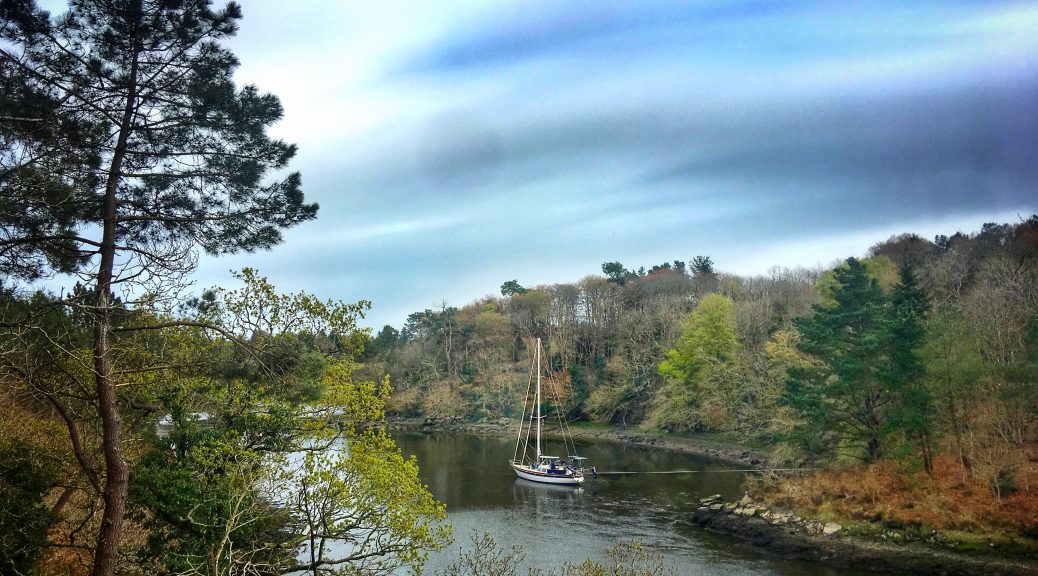
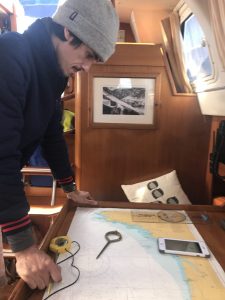
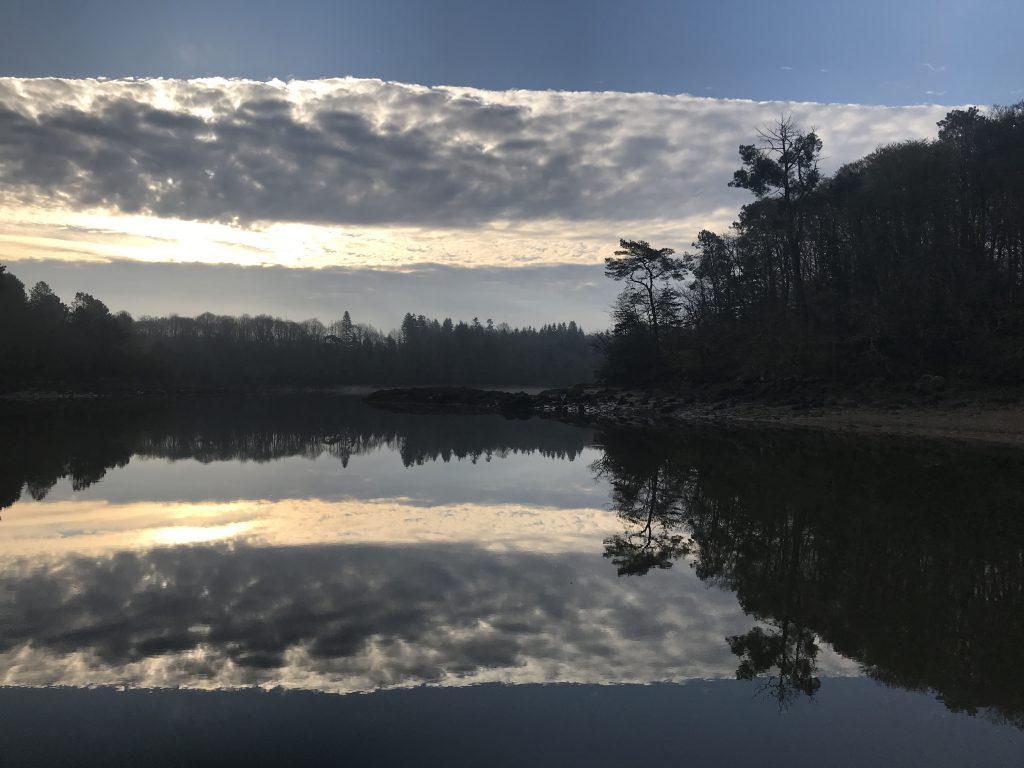 The next day the mist hung atmospherically over the water. On going ashore wild oysters were found here on the banks. Their shells fragile but strong each one totally unique. Barnicles having found their home on many of them, made up of lines like contours as if they are little planets made up up many kinds of ivory white.
The next day the mist hung atmospherically over the water. On going ashore wild oysters were found here on the banks. Their shells fragile but strong each one totally unique. Barnicles having found their home on many of them, made up of lines like contours as if they are little planets made up up many kinds of ivory white.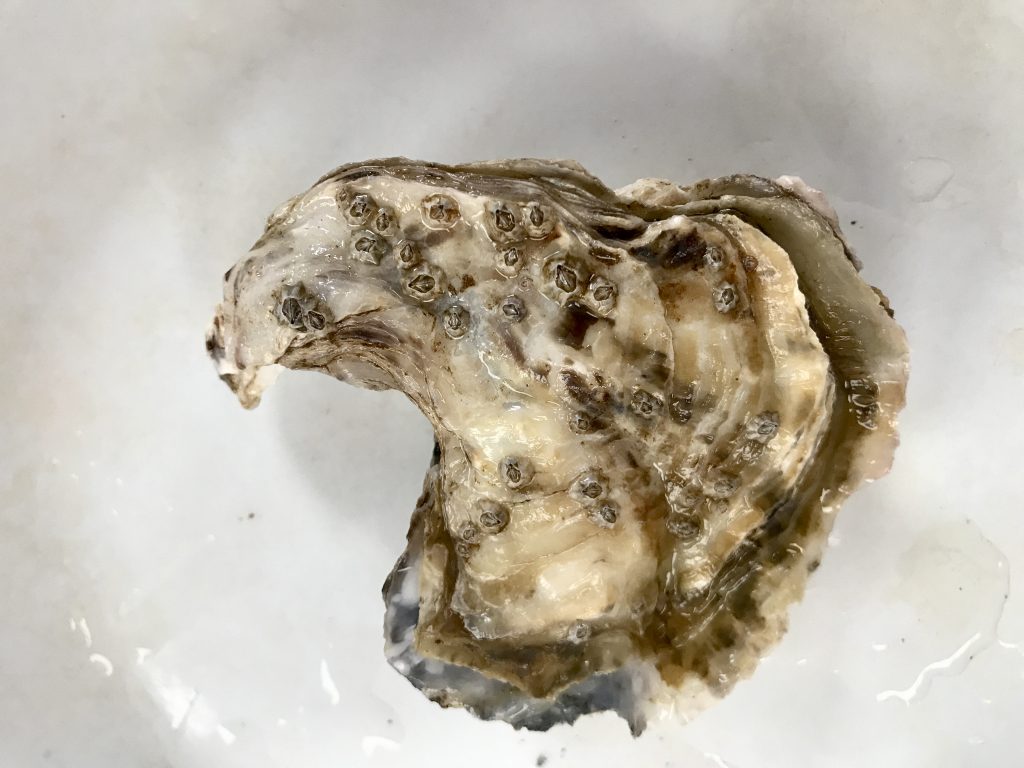
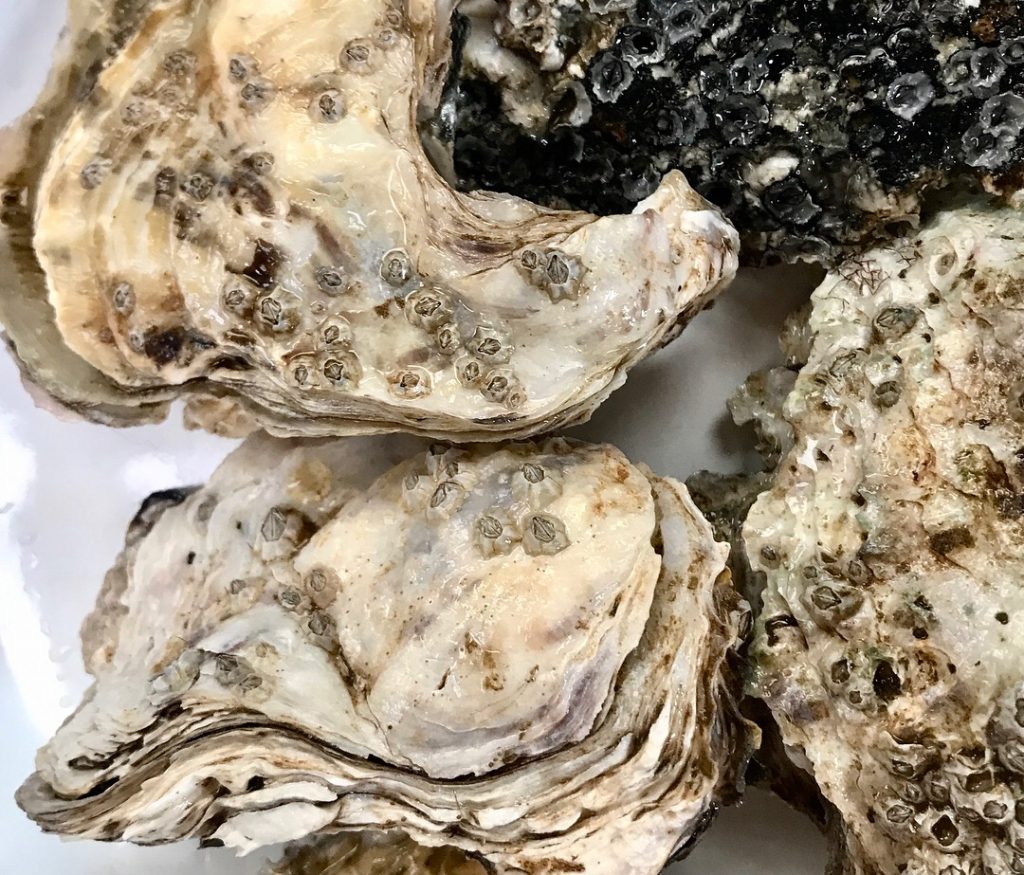 Tim got to work early on dismanterly the inmast furling, this had been problematic since the beginning making it very difficult for one of us to take the main sail in or out easily or quickly. He is very good at fixing things, almost everything, but this was always going to be a challenge and we were now in an isolated anchorage, at least up a river and not out to sea but in a remote location if anything didn’t quite go to plan or any other materials needed.
Tim got to work early on dismanterly the inmast furling, this had been problematic since the beginning making it very difficult for one of us to take the main sail in or out easily or quickly. He is very good at fixing things, almost everything, but this was always going to be a challenge and we were now in an isolated anchorage, at least up a river and not out to sea but in a remote location if anything didn’t quite go to plan or any other materials needed. 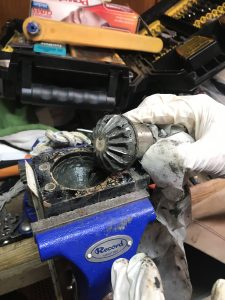 A long day was spent taking panals off, degreasing, regreasing, checking bolts and cogs, readjusting ropes. True to character all back in place by the end of the day and mission accomplished the sail could be furled and defurled much more easily. This was significant as it makes being able to handle the boat solo much easier and if at times conditions are getting more difficult the sails need to be got in as quickly and easily as possible. The forfeit for the feat though was a race, run, strip to bow, dive into freezing water and swim to the stern to calm down after all the excitement!!
A long day was spent taking panals off, degreasing, regreasing, checking bolts and cogs, readjusting ropes. True to character all back in place by the end of the day and mission accomplished the sail could be furled and defurled much more easily. This was significant as it makes being able to handle the boat solo much easier and if at times conditions are getting more difficult the sails need to be got in as quickly and easily as possible. The forfeit for the feat though was a race, run, strip to bow, dive into freezing water and swim to the stern to calm down after all the excitement!!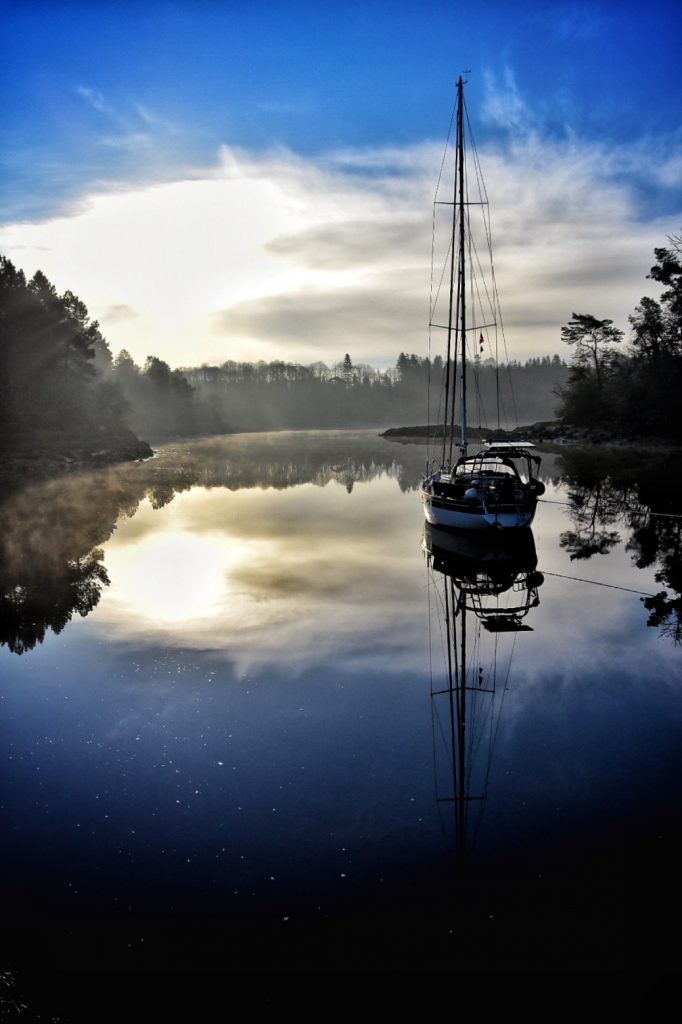
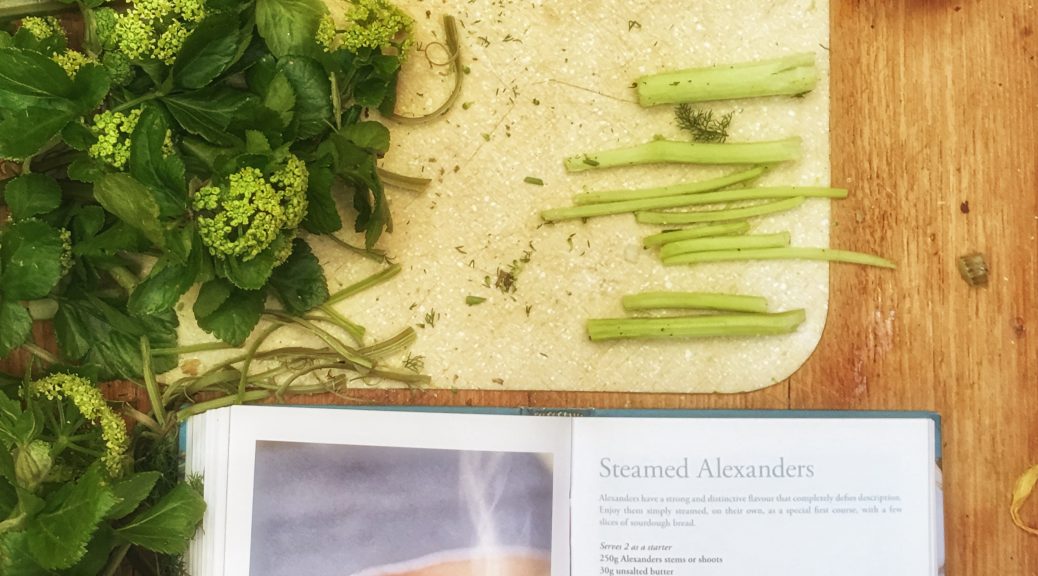
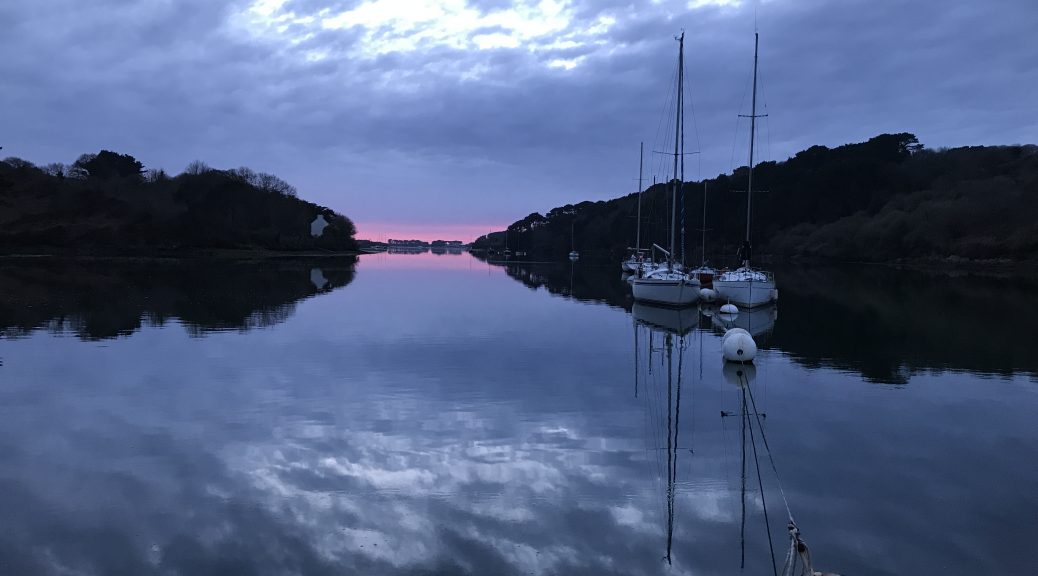
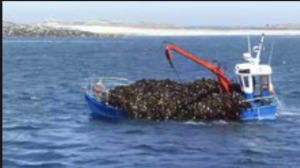 One thing which is retained from the past is the tradition of seaweed harvesting. Every now and then the ‘Geomoniers’ as they are known, glided past in a flat bottomed boat with a small crane attached piled high with this slimy iodine rich crop. In the past and the present day they were used as fertilisers and spread on fields but today there are also more sophisticated uses in the pharmaceutical industry for cosmetics and as natural ingredients in herbal remedies.
One thing which is retained from the past is the tradition of seaweed harvesting. Every now and then the ‘Geomoniers’ as they are known, glided past in a flat bottomed boat with a small crane attached piled high with this slimy iodine rich crop. In the past and the present day they were used as fertilisers and spread on fields but today there are also more sophisticated uses in the pharmaceutical industry for cosmetics and as natural ingredients in herbal remedies.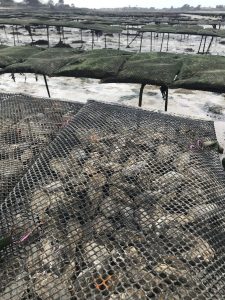
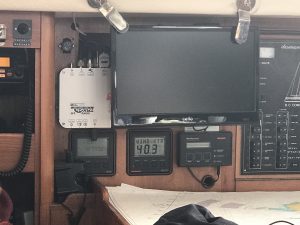 We were waiting for conditions to calm before rounding the Western most part of France and tackling the Chenal Du Fort. However, fustratingly our progress was once more hampered by more bad weather and strong winds predicted so the decision was made to move up
We were waiting for conditions to calm before rounding the Western most part of France and tackling the Chenal Du Fort. However, fustratingly our progress was once more hampered by more bad weather and strong winds predicted so the decision was made to move up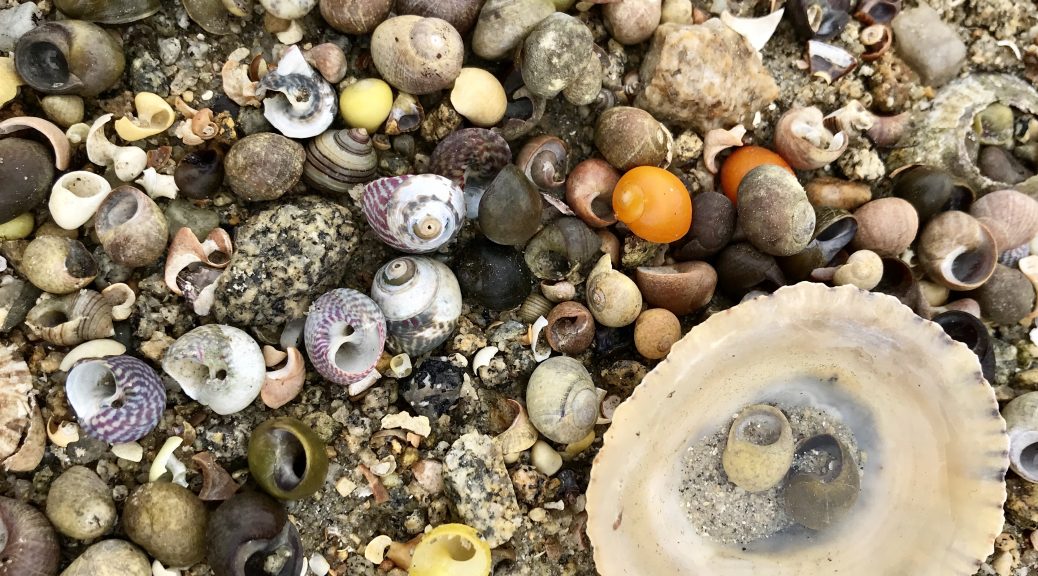
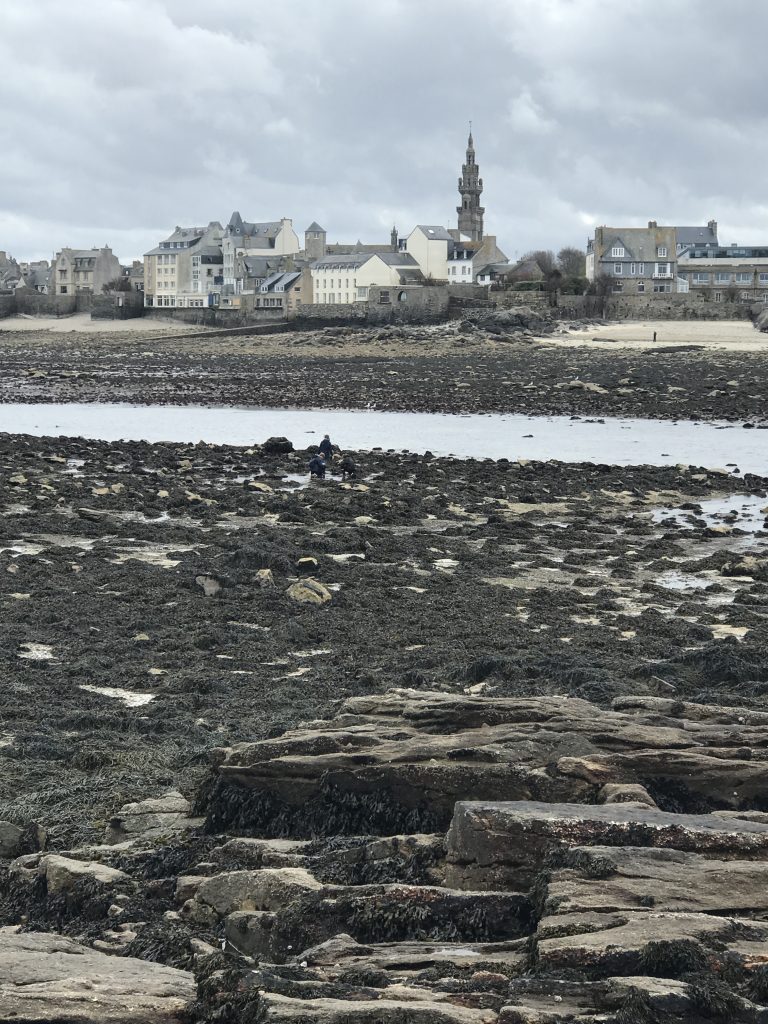
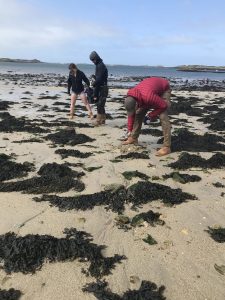
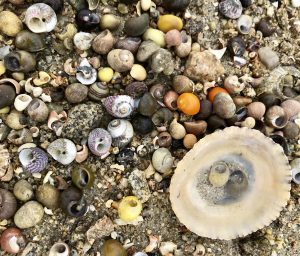 Of course once garlic, parsley and butter was added this could have been true of any little morsel and it certainly was a little morsel if a little chewy, tasty enough. Another intriguing find came as Tim shouted across the raw of the sea “This man has steak of the sea!” The Roscoffian bought out a huge fleshy creature the size of a small hamburger which came out of the most beautiful of turquoise inlaid iridescent shells. He smacked his lips with appreciation of “le steak du mer”! The other thing which was learnt about Roscoff and as you will find out in true Tricolour style this is mainly about eating, was that this was the port the ‘French Jonnys’ as the English like to put it would be sent off to work from dawn to dusk with nothing but their gallic charm, seductive broken English and strings of up to 100kg of pink onions to sell to passing housewives.
Of course once garlic, parsley and butter was added this could have been true of any little morsel and it certainly was a little morsel if a little chewy, tasty enough. Another intriguing find came as Tim shouted across the raw of the sea “This man has steak of the sea!” The Roscoffian bought out a huge fleshy creature the size of a small hamburger which came out of the most beautiful of turquoise inlaid iridescent shells. He smacked his lips with appreciation of “le steak du mer”! The other thing which was learnt about Roscoff and as you will find out in true Tricolour style this is mainly about eating, was that this was the port the ‘French Jonnys’ as the English like to put it would be sent off to work from dawn to dusk with nothing but their gallic charm, seductive broken English and strings of up to 100kg of pink onions to sell to passing housewives.